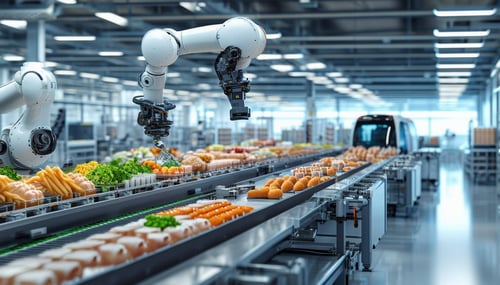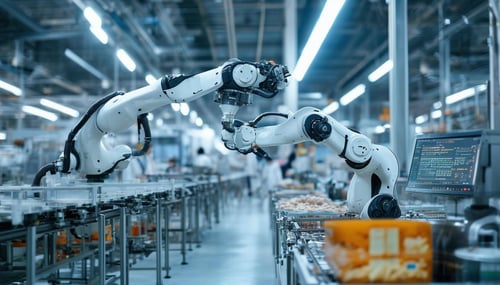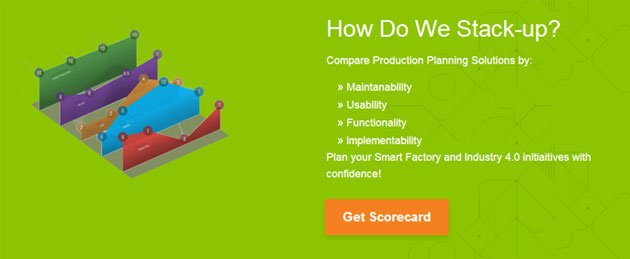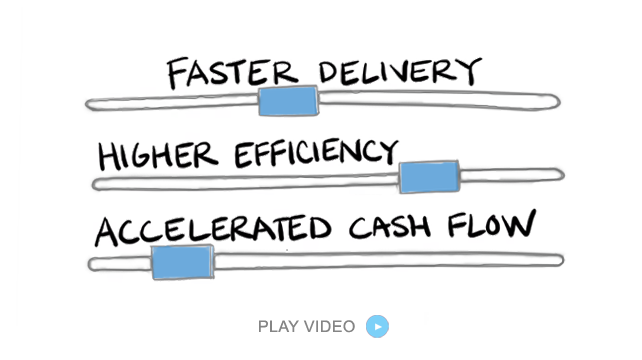The Role of Robotics in Food and Beverage Manufacturing: Enhancing Efficiency through Smart Integration
In food and beverage manufacturing, robotics is no longer just an option; it’s a requisite for maintaining efficiency, consistency, and competitiveness. With shifting consumer demands, regulatory pressures, and labor shortages, manufacturers are turning to automation to meet production goals while maintaining high-quality standards.
However, to fully harness the potential of robotics, it is crucial to integrate these technologies seamlessly with advanced production planning and enterprise resource planning (ERP) systems.

Robotics in Food and Beverage Manufacturing
Robotics in food and beverage manufacturing encompasses a wide range of applications, from handling raw materials to packaging and palletizing finished products. The industry has seen significant adoption of collaborative robots (cobots), robotic arms, and autonomous mobile robots (AMRs) to optimize workflows and reduce human intervention in repetitive tasks.
Key applications of robotics in the food and beverage sector include:
Automated Ingredient Handling – Robots ensure precise ingredient mixing, minimizing waste and improving consistency.
Pick-and-Place Operations – Advanced vision systems allow robots to handle delicate food products with precision.
Robotic Packaging and Palletizing – Automated packaging systems enhance speed and reduce manual labor requirements.
Hygienic and Sanitary Processing – Specialized food-grade robots ensure compliance with health regulations.
Inspection and Quality Control – Vision-guided robots identify defects and ensure product quality.
While these robotic systems bring undeniable advantages, their true potential can only be unlocked through effective integration with enterprise-wide systems, such as SAP, Oracle, Microsoft, Kinaxis, or Aveva, in conjunction with advanced production scheduling software like PlanetTogether.
![]()

The Role of Smart Integration: Robotics, ERP, and APS
Implementing robotics without an integrated system can lead to isolated efficiencies but not end-to-end optimization. The real benefits emerge when robotics is synchronized with production planning and scheduling tools. Here’s where integration with PlanetTogether and ERP solutions like SAP, Oracle, Microsoft, Kinaxis, or Aveva becomes a game-changer.
Enhanced Production Scheduling and Real-Time Adaptation
With robotics integrated into PlanetTogether’s Advanced Planning and Scheduling (APS) system, food and beverage manufacturers can achieve:
Dynamic scheduling that adjusts in real-time based on robotic performance and material availability.
Optimized throughput, ensuring robots operate at peak efficiency while reducing bottlenecks.
Predictive analytics, allowing manufacturers to forecast potential issues and make proactive adjustments.
For example, if a robotic packaging line is operating below capacity due to maintenance, PlanetTogether, integrated with SAP or Oracle, can automatically adjust production schedules, reassign tasks, and re-optimize the workflow.
Supply Chain Synchronization
Robots are only as effective as the materials and processes feeding them. Integration with ERP platforms such as Microsoft Dynamics, Kinaxis, or Aveva ensures:
Automated material replenishment, preventing production halts due to raw material shortages.
Improved inventory accuracy, reducing waste and ensuring JIT (Just-in-Time) production runs smoothly.
Seamless supplier collaboration, ensuring production schedules align with inbound supply chain logistics.
Data-Driven Continuous Improvement
By merging robotic data with APS and ERP insights, manufacturers can:
Analyze machine efficiency and downtime patterns to refine workflows and improve asset utilization.
Track production KPIs, linking robotic output to overall manufacturing performance.
Leverage AI-driven insights for predictive maintenance, reducing unplanned downtime and maximizing uptime.
Overcoming Challenges in Robotics Integration
While the benefits are clear, integrating robotics into a fully connected manufacturing ecosystem comes with challenges. Operations Directors in food and beverage manufacturing must consider:
Interoperability – Ensuring seamless communication between legacy systems, ERP, APS, and robotic controllers.
Scalability – Choosing robotic solutions that can scale with business growth and evolving production needs.
Workforce Adaptation – Training employees to collaborate with robotics and manage automated processes effectively.
Cybersecurity – Protecting connected systems from cyber threats that could disrupt operations.
For Operations Directors in the food and beverage industry, investing in robotics is not just about automation—it’s about smart automation. The key to unlocking the full potential of robotics lies in integrated planning, real-time adaptability, and data-driven decision-making. By synchronizing robotics with PlanetTogether and enterprise ERP Systems, manufacturers can transform production efficiency, reduce waste, and maintain high-quality standards while positioning themselves for the future of smart manufacturing.
Are you ready to take your manufacturing operations to the next level? Contact us today to learn more about how PlanetTogether can help you achieve your goals and drive success in your industry.
Topics: PlanetTogether Software, Integrating PlanetTogether, Enhanced Production Scheduling, Data-Driven Continuous Improvement, Food and Beverage Manufacturing, Supply Chain Synchronization





















LEAVE A COMMENT